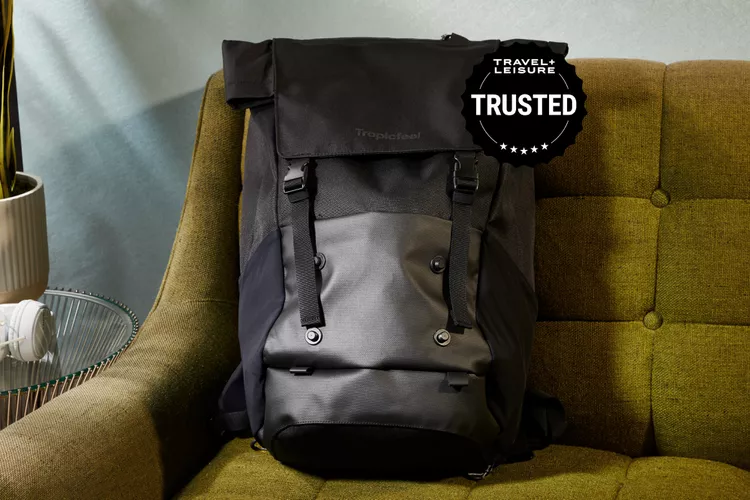We independently evaluate all of our recommendations. If you click on links we provide, we may receive compensation.
Our Top Picks
8000Kicks Everyday Backpack earned our top pick.
Fact checked by Rich Scherr
Between daily commutes, mountain hikes, and simply making fashion statements, backpacks are essential in a variety of scenarios. While they are often categorized by activity and use, it is also important to factor in a backpack’s sustainability. However, making sense of product descriptions, company claims, and sustainability credentials can be confusing. To assist, we have rounded up the best sustainable backpacks, including top picks for different activities, styles, and features. We also consulted sustainable fashion and product experts for tips on eco-friendly shopping.
Our top picks were informed by our own testing and the sustainability of each backpack at the product and company level. In our testing, we evaluated backpacks based on their capacity, design, comfort, durability, and value. Meanwhile, key sustainability indicators include the backpack’s materials and the company’s supply chain, labor practices, sustainability commitments, and philanthropic contributions to environmental and social justice initiatives.
While we’re delighted that many brands are committed to supporting people and the planet, the 8000Kicks Everyday Backpack earned the best overall pick for its sustainable hemp materials, handy features, and the company’s investment in renewable energy.
Best Overall
8000Kicks Everyday Backpack

$139 at Amazon View on 8000kicks.com
Why We Love It
- Besides its production of the world’s first waterproof hemp backpack, we appreciate the company’s commitment to transparency and reducing emissions from the manufacturing process.
What to Consider
- The bag doesn’t have an internal zip pocket, though some may find the hidden back panel zip pocket sufficient.
Made from hemp, the 8000Kicks Everyday Backpack boasts durability and waterproof protection without using petroleum products, dyes, or toxic chemicals. Hemp is a quick-growing crop that requires less water than cotton—another sustainability perk. The backpack is compressible, allowing travelers to adjust it between 18 liters and 30 liters. It has a roll-top closure system that opens wide for easily stashing belongings. The Everyday Backpack has a range of pockets and compartments for versatile functionality. This includes dual water bottle pockets, a front zip pocket, a USB pocket, and an anti-theft pocket on the back. As the company’s name suggests, 8000Kicks built its business on making shoes (the vegan, recycled variety). With the Everyday Backpack, the brand has continued its tradition of sustainability and transparency. The company discloses greenhouse gas emissions data and sources nearly half of its energy used in manufacturing from clean energy. 8000Kicks also only uses materials that meet the OEKO-TEX Standard 100 certification requirements.
The Details: 100 percent hemp | 2.3 pounds | 30-liter capacity
Our Testing Process
We evaluated backpacks through a series of tests in the real world and our New York City lab. Each tested item was assessed according to its capacity, durability, comfort, design, and value. We packed them with clothing, gear, and essentials, according to their stipulated use (e.g., laptop bag, hiking backpack, etc.) to evaluate the capacity of each backpack. We considered the support, ventilation, and fit on a series of walks to rate comfort for each backpack. To test the durability in a shorter time frame, backpacks went through a drop test to see how they stand up to wear and tear. Meanwhile, we accounted for the ease of use, aesthetics, and overall functionality when rating the design for a given backpack.
Tips for Buying a Sustainable Backpack
Be mindful of greenwashing
Many brands are aware that customers care about sustainability, so those with ethical and sustainable credentials typically include it in their product descriptions or website. The push towards sustainability has also seen a rise in “greenwashing,” which is when a company creates a false impression of its environmental impact.
Annie Morris, editor-in-chief at Made in Canada, says to keep an eye out for bold, unsubstantiated claims about sustainability. “If a brand claims that their backpack is ‘100 percent sustainable’ without providing any proof or details, that should raise a red flag,” Morris says.
Prioritize transparency
Besides making their own claims, companies can demonstrate transparency through certifications and verification by third parties. This includes how they source materials, labor practices, and philanthropic work. Christinee points to B Corps Certification, 1% for the Planet, and Fair Trade Certified as trusted indicators of sustainability and good labor practices. However, Christinee notes that smaller brands may not be in a position to pay for certification. “But if they’re willing to share their impact on their website, that’s a sign the brand is trying to build trust,” she says.
Invest in pieces that will last
Most everyone is familiar with the three R’s: reduce, reuse, and recycle. Reducing the consumption of natural resources has the greatest environmental impact, thus the top ranking in the three-tiered hierarchy. Selecting a backpack that will endure years of use is a sustainable investment—both ecologically and financially. In other words, “the most sustainable items are those that you use again and again… and again,” Christinee says.
Frequently Asked Questions
-
What is sustainability?
In broad terms, sustainability means fulfilling the needs of the present without compromising the needs of the future. Sustainability also involves a balance between the environment, social equity, and the economy so that one doesn’t come at the cost of another.
-
What makes a backpack sustainable?
We evaluated each company’s materials, labor practices, supply chain, and support for environmental and social equity initiatives when selecting the most sustainable backpacks, as all these factors impact people and the planet.





